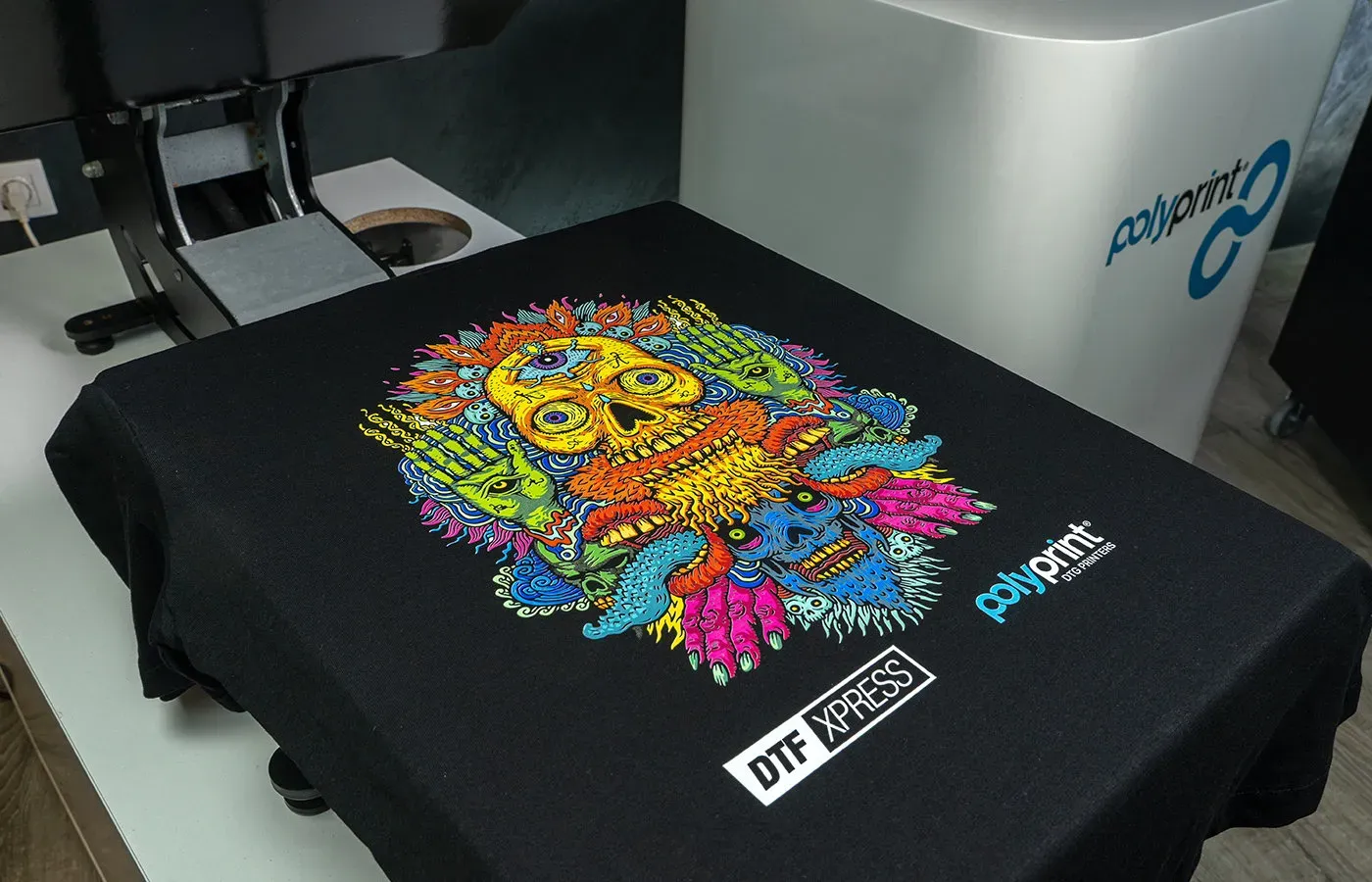DTF printing, or Direct to Film printing, has become a game-changer in the world of textile printing. This cutting-edge technique offers the ability to create stunning, high-quality designs that can be effortlessly transferred onto a variety of fabrics. From t-shirts to tote bags, the vibrant colors and intricate details achieved through DTF printing are unmatched. To get the most out of your DTF printing experience, employing effective DTF printing tips and refining your skills in the DTF printing process is essential. In this post, we’ll provide you with 10 must-know tips to improve DTF prints and elevate your printing techniques like never before.
Known for its efficiency and impressive results, Direct to Film printing is a modern approach that has transformed how prints are applied to textiles. Otherwise referred to as DTF, this process involves transferring detailed images directly from a film onto fabric, making it ideal for both personalized apparel and bulk orders. By understanding the nuanced techniques and optimal practices associated with this innovative printing method, one can significantly enhance the quality of their outputs. Equipped with essential DTF printing techniques, you’ll be able to create prints that not only resonate with vibrant colors but also boast excellent durability. Let’s delve into the critical steps that will help you maximize your DTF printing capabilities.
Understanding the DTF Printing Process
Direct to Film (DTF) printing is an innovative approach that has transformed textile printing. This technique allows high-quality designs to be printed onto transfer films, which are then applied to a wide variety of fabric surfaces. The process begins with printing designs using specially formulated inks on a film substrate. After printing, powders are adhered to the wet ink and cured through heat, creating a durable transfer that can be easily applied to garments using a heat press. This versatile method not only permits vibrant colors and detailed graphics but also ensures that prints remain vibrant even after multiple washes.
One of the significant advantages of DTF printing over traditional methods is the ability to print directly onto film, which can be stored and used later, thus allowing for better workflow management. It eliminates the need for screens, making it a cost-effective solution for custom designs and small production runs. By understanding the detailed steps involved in the DTF printing process, you can better plan your print jobs and achieve the desired outcomes.
Tips for Improving DTF Prints
To achieve the highest quality prints in DTF printing, there are several tips that can significantly improve your results. Firstly, using high-density inks designed specifically for DTF applications enhances color vibrancy and ensures better adhesion to textile surfaces. Additionally, ensuring that your prints are correctly cured will preserve the colors and prevent them from cracking or fading over time. It’s essential to follow manufacturer guidelines for the appropriate curing temperatures and durations.
Another useful tip is to conduct regular test swatches before committing to larger production runs. This practice allows you to make necessary adjustments regarding color settings and fabric compatibility. Small adjustments can lead to notable improvements in both quality and durability of the prints, particularly when targeting specific fabrics for your designs.
Essential DTF Printing Techniques
Employing the right DTF printing techniques can greatly enhance the overall printing experience. One fundamental technique is pre-treating fabrics before printing. Pre-treatment helps create a proper surface for the inks, leading to a smoother finish and stronger adhesion. Choosing the right pre-treatment additive depending on the fabric type is crucial to achieving optimal results.
Furthermore, utilizing a reliable heat press with even pressure distribution can significantly impact the success of your DTF transfers. Improper pressure or uneven heat can compromise print quality, leading to fading or peeling over time. Mastering these DTF printing techniques not only improves the quality of your prints but also extends their longevity.
Effective DTF Printing Tips for Beginners
For those new to DTF printing, starting with the basics is crucial for long-term success. One effective tip is to thoroughly understand your printer settings. Proper adjustments to ink density and quality settings based on the specific materials used can enhance print quality tremendously. Familiarize yourself with the functionality of your DTF printer by consulting the manufacturer’s guidelines to optimize your printing results.
Additionally, keep your workspace organized and properly maintain your printing equipment. Ensure that the printer heads are regularly cleaned, and check for any blockages in the ink lines. A clean and organized workspace minimizes errors and enhances productivity, allowing you to focus on refining your designs and mastering the DTF printing process.
Controlling Moisture for Better DTF Printing
Moisture control is a crucial component in DTF printing that can dramatically affect the quality of the final product. Excess moisture can cause smudging or blurriness during the transfer process, leading to disappointing results on the fabric. To combat this, it’s important to keep both your printed transfers and the films in a controlled, dry environment until ready for use. Utilizing silica gel packs or moisture-absorbing materials in your storage area can also be beneficial.
Furthermore, ensuring that the fabrics you plan to print upon are dry and free from dampness can help achieve clear and vibrant prints. Moisture in fabric can disrupt the adhesion of the inks during the heat transfer process, potentially causing imperfections. By effectively managing moisture levels, you will significantly improve the overall quality and durability of your DTF prints.
Educating Customers on DTF Printed Products
An often-overlooked aspect of successful DTF printing is customer education. Once you deliver DTF printed items, it’s vital to provide clear care instructions to ensure your customer can maintain the quality and longevity of the prints. Inform them about the best washing temperatures and care methods to prevent damage. This not only enhances customer satisfaction but also establishes trust and can lead to repeat business.
Additionally, consider creating a care guide that explains how DTF prints can withstand various conditions like wash cycles and heat. By equipping your customers with knowledge about caring for their items, you enhance their overall experience and help them appreciate the quality of your products.
Frequently Asked Questions
What is DTF printing and how does the DTF printing process work?
DTF printing, or Direct to Film printing, is a method where designs are printed onto a special film before being transferred to fabrics. The DTF printing process involves printing the design on a film, applying adhesive powder, curing it, and finally heat pressing it onto the desired fabric. This technique allows for vibrant and durable prints.
What are some essential DTF printing tips for beginners?
For beginners, key DTF printing tips include using high-quality films, maintaining printer cleanliness, adjusting ink settings for your specific inks, and conducting test swatches before larger runs. These practices can greatly enhance the quality and efficiency of your DTF printing.
How can I improve DTF prints for better durability?
To improve DTF prints, ensure proper curing processes by following recommended time and temperature settings. Pre-treating fabrics, maintaining humidity control, and storing inks properly also contribute to enhancing the durability and quality of DTF prints.
What materials are best for DTF printing?
DTF printing is versatile and works best on cotton, polyester, and cotton-poly blends. Choose high-quality fabrics that have good dye affinity to ensure optimal ink adhesion and vibrant color output in your DTF printing projects.
What temperature settings are ideal for the DTF printing process?
The ideal temperature settings for DTF printing depend on the specific inks and films used. Always consult the manufacturer’s recommendations for curing temperatures, as applying the correct heat is vital for achieving strong adhesion and high-quality prints.
How can I troubleshoot common issues in DTF printing?
Common DTF printing issues can often be troubleshot by checking for clogged nozzles, ensuring optimal ink density settings, maintaining printer cleanliness, and controlling environmental moisture levels. Regular maintenance and following industry best practices are key to minimizing problems.
| Tip Number | Key Point | Description |
|---|---|---|
| 1 | Use High-Quality Films | Invest in superior films to enhance image clarity and adhesion. |
| 2 | Optimal Ink Settings | Adjust ink density settings for better color vibrancy and durability. |
| 3 | Maintain Printer Cleanliness | Regularly clean printer components to avoid clogs and inconsistencies. |
| 4 | Correct Temperature Settings | Set appropriate curing temperatures according to ink recommendations. |
| 5 | Pre-Treatment of Fabrics | Enhance ink adhesion by pre-treating fabrics with compatible additives. |
| 6 | Proper Curing Process | Heat press with even pressure and correct curing time for durability. |
| 7 | Test Swatches | Conduct test prints to make adjustments before bulk orders. |
| 8 | Moisture Control | Keep film and printed transfers dry to avoid quality issues. |
| 9 | Storage of Inks | Store inks in a dark, cool place to maintain their quality. |
| 10 | Customer Education | Provide care instructions to customers for better longevity of prints. |
Summary
DTF printing is a transformative technique that allows for vivid and detailed fabric designs, greatly enhancing printing capabilities. To achieve the best results with DTF printing, it is critical to follow best practices such as using high-quality films, adjusting ink settings, and ensuring a clean printing environment. By adhering to these guidelines, you can ensure that your prints are not only visually appealing but also durable, ultimately leading to enhanced customer satisfaction. Whether you’re a professional or a hobbyist, these tips will streamline your printing process and optimize your results.

